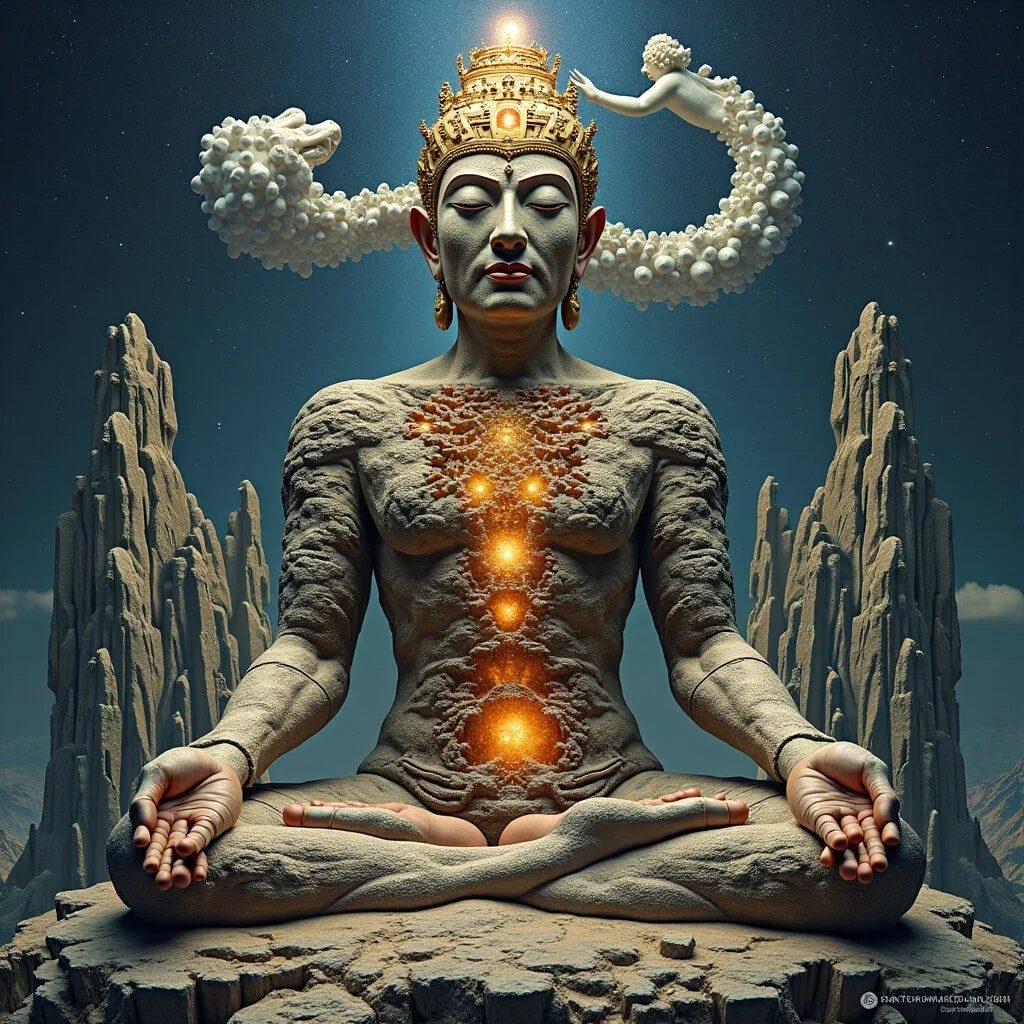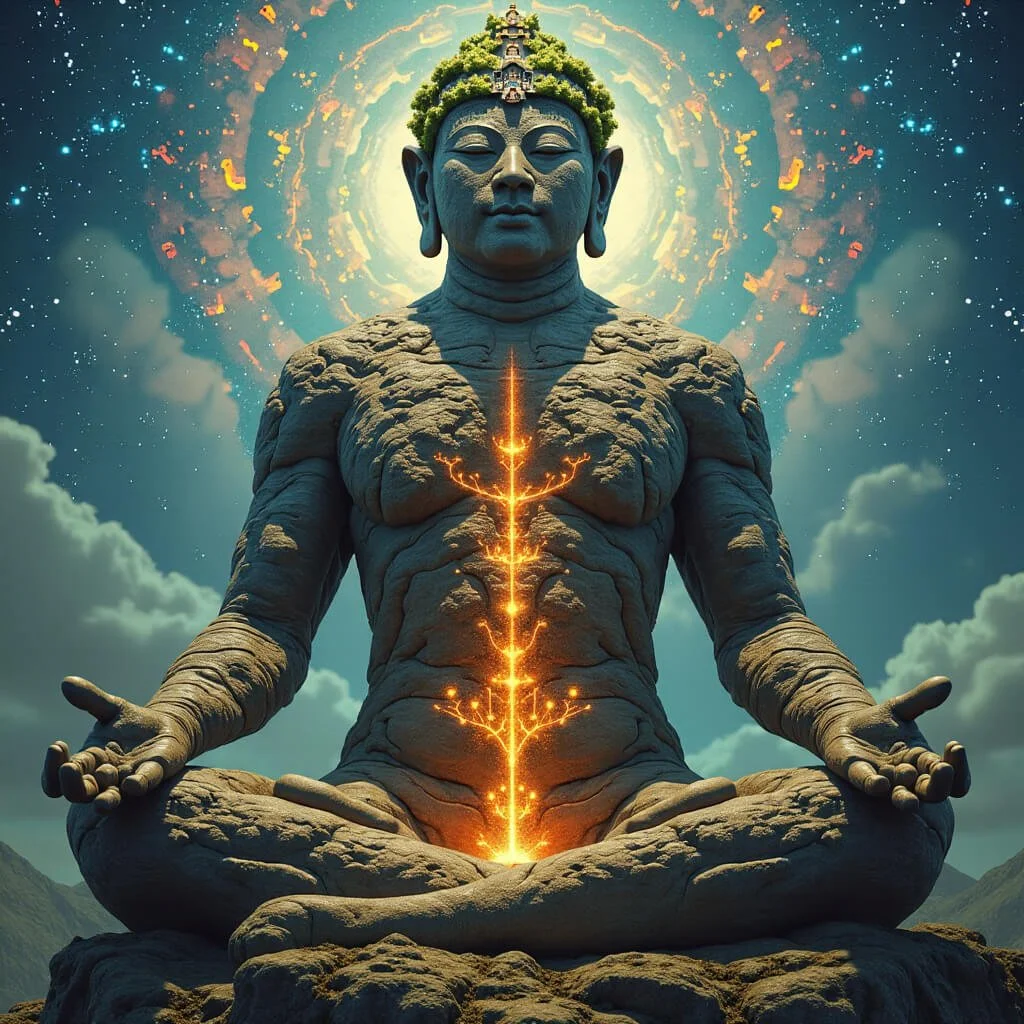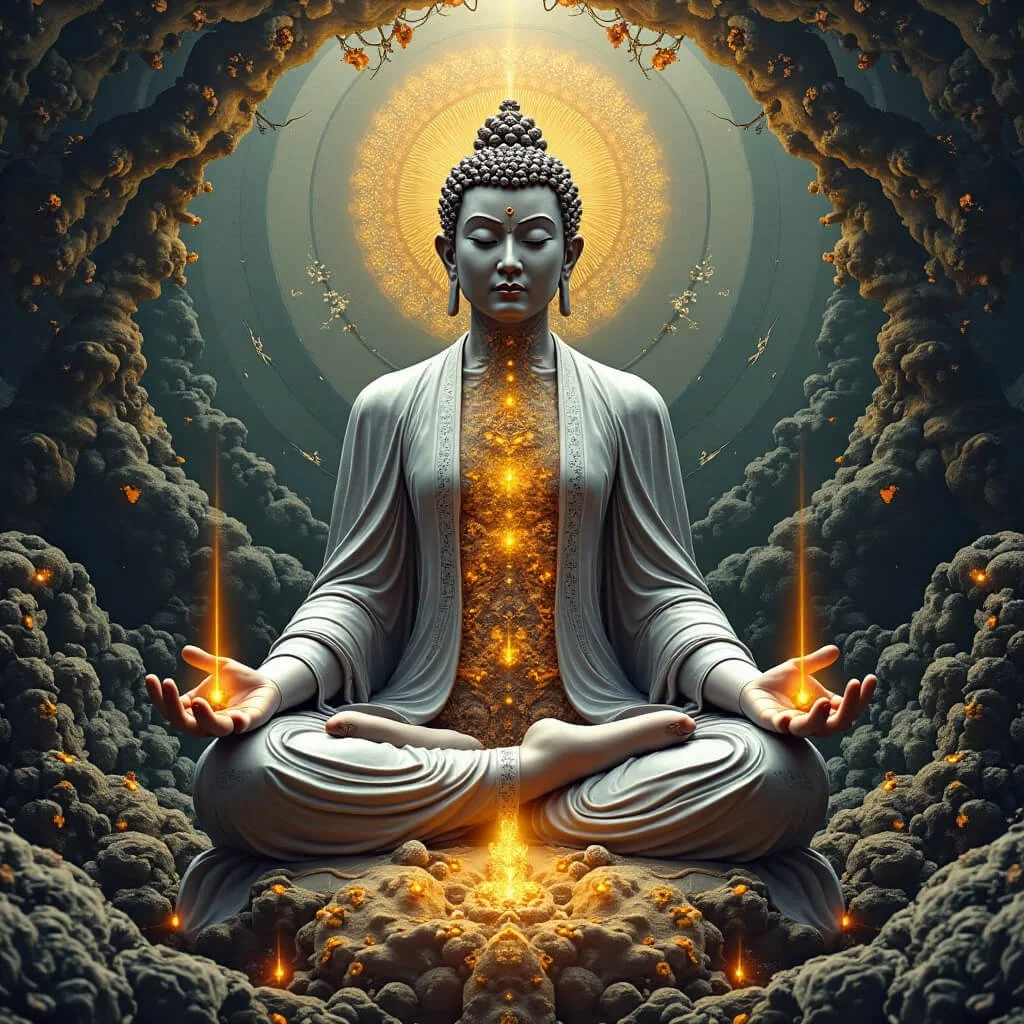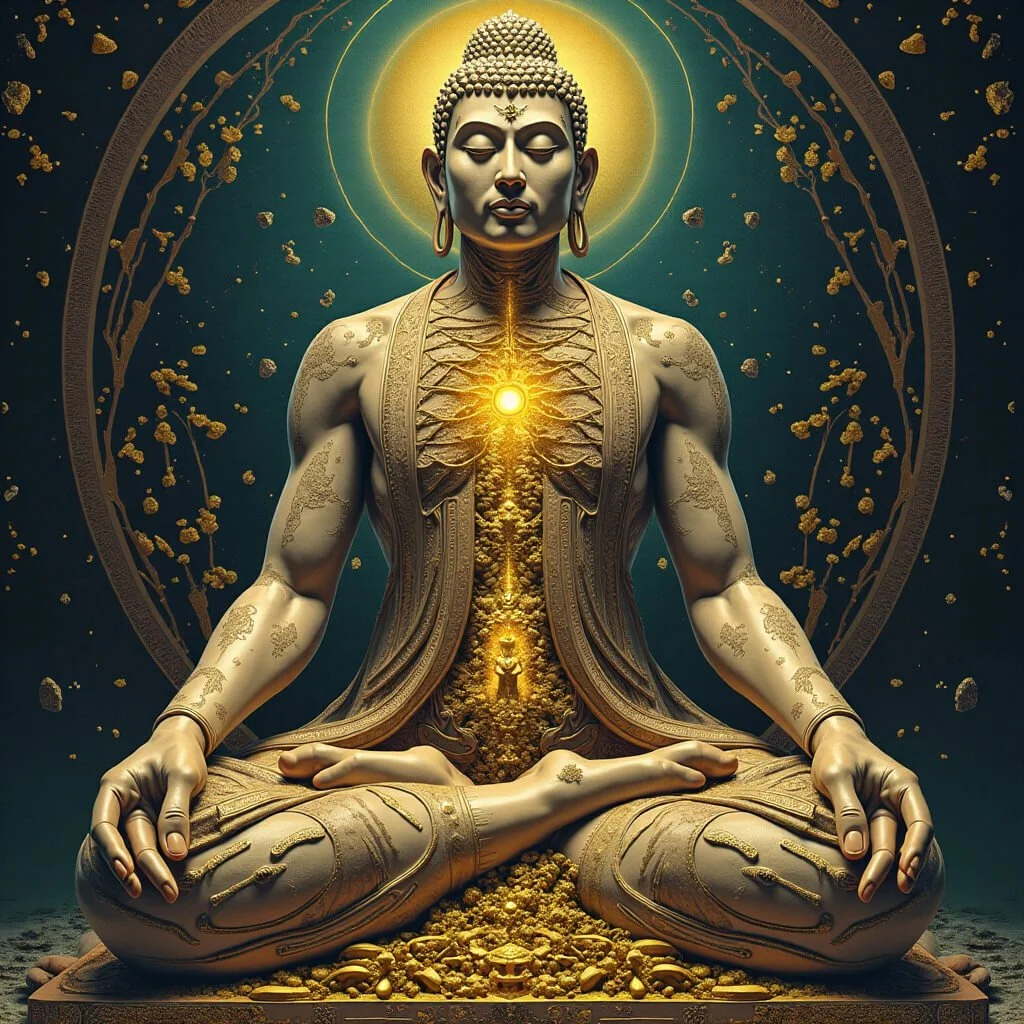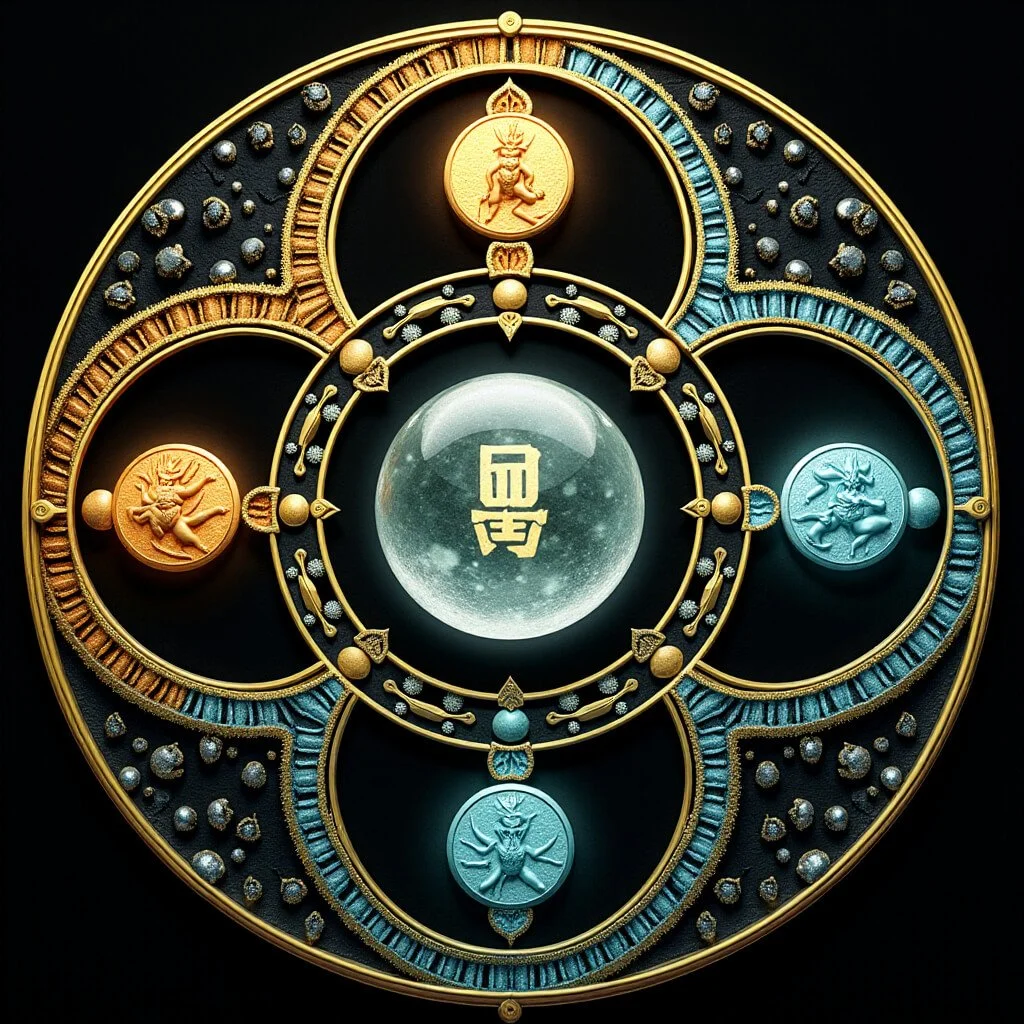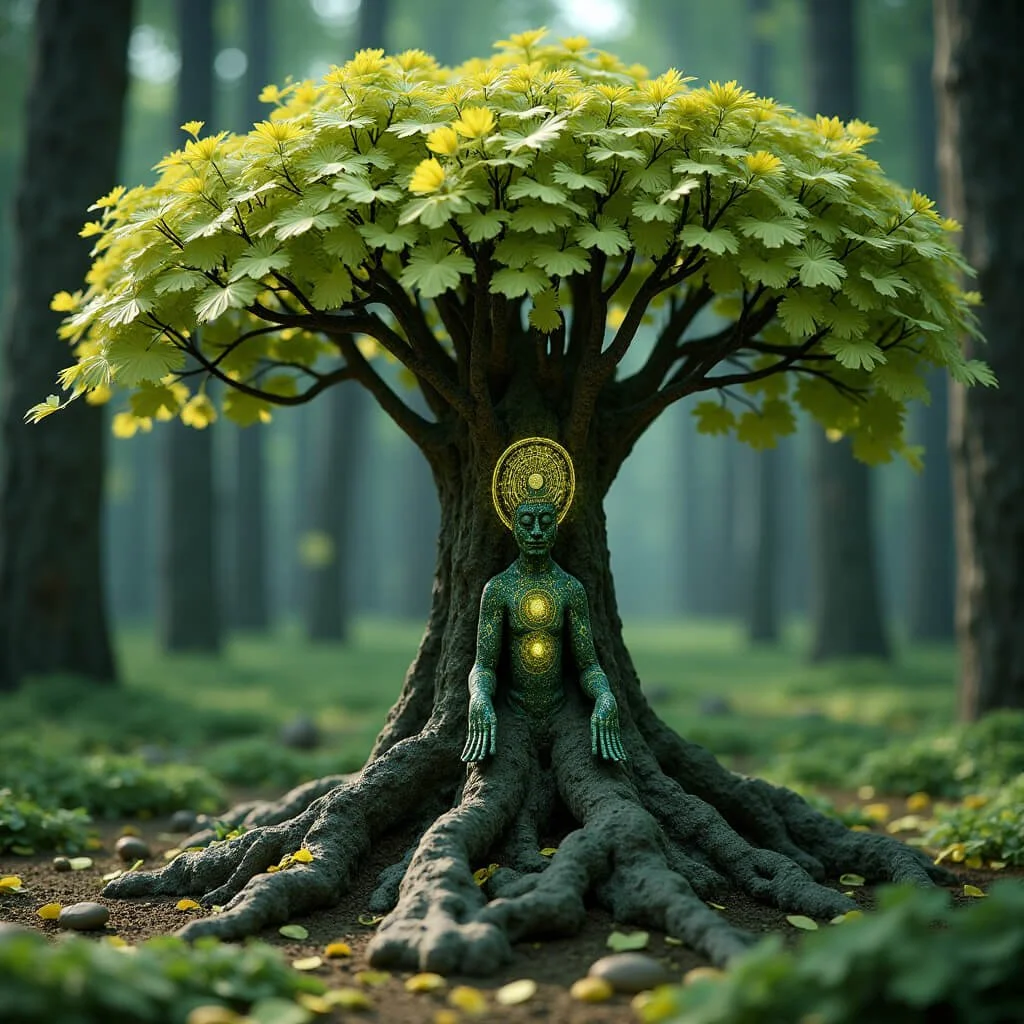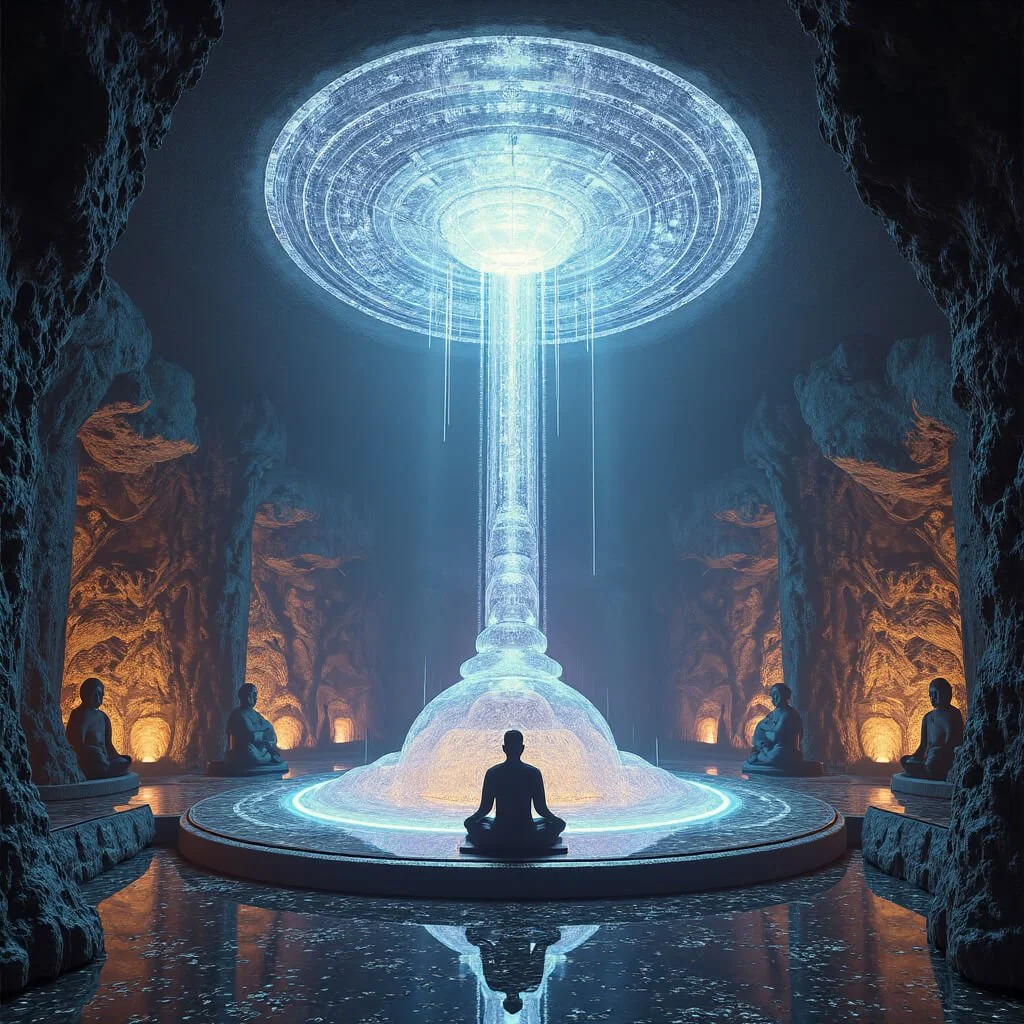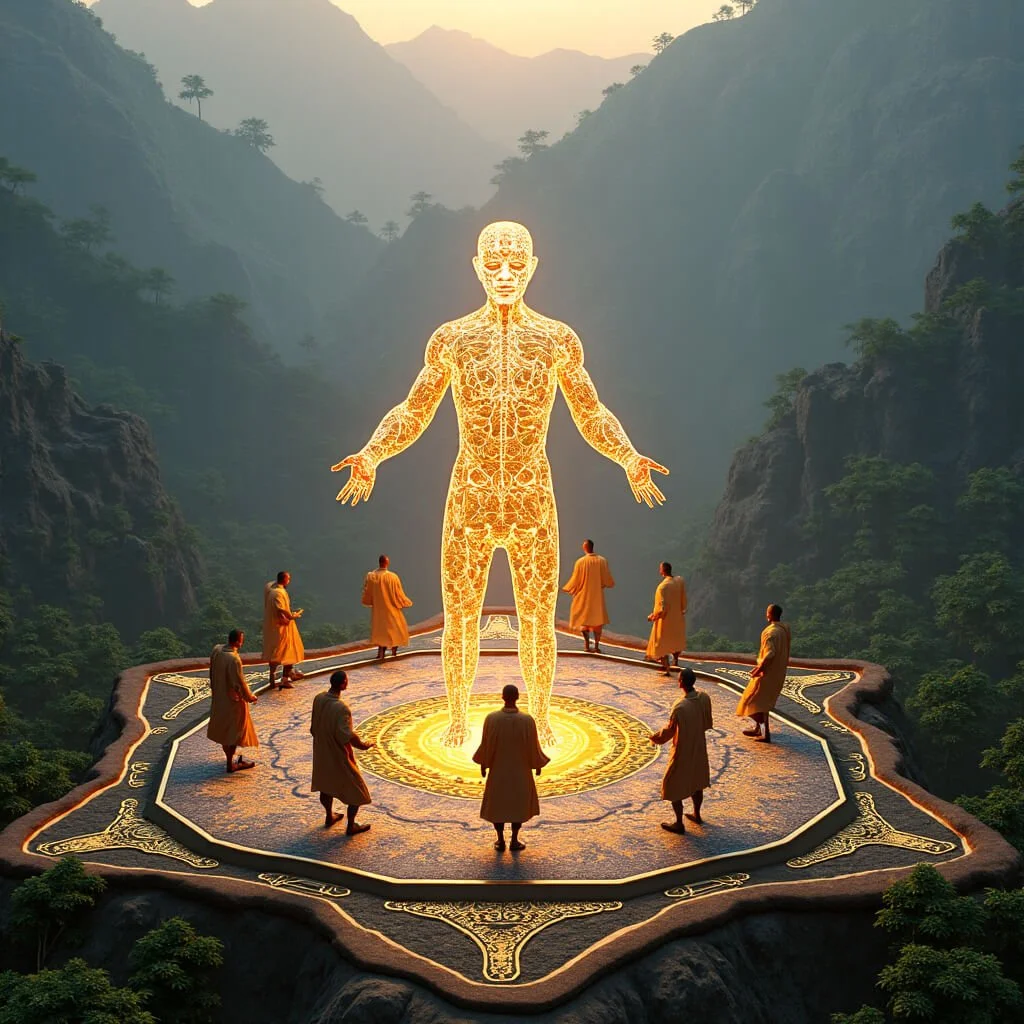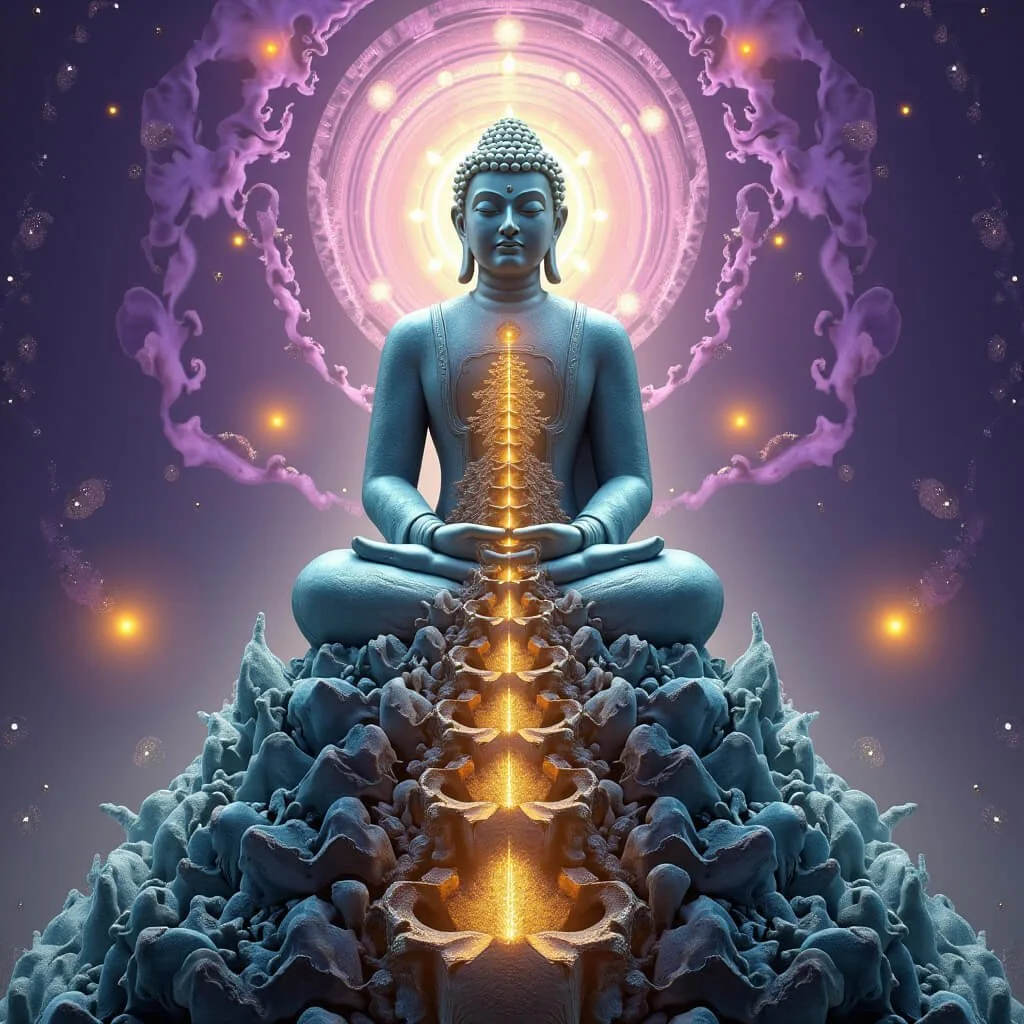Bodhidharma and the Dreaming Mountain: Fractal Origins of the Shaolin Transmission
A Mythopoetic Odyssey Through Songshan, Shaolin, and the Dreaming Dharma
The Living Bridge Between Worlds
In the purple mist that clings to the peaks of Songshan, where ancient ginkgo trees whisper secrets older than written history, lies a story that challenges our fundamental understanding of how wisdom traditions emerge, adapt, and transform across cultures and centuries.
This is not merely the tale of a monastery's founding or the legendary origins of martial arts, it is an exploration of consciousness itself, as it manifests through the dynamic interplay between human awareness, natural environment, and the eternal quest for meaning that drives all authentic spiritual inquiry.
The Shaolin Temple complex, perched on the shoulders of China's Central Sacred Mountain, represents one of humanity's most successful experiments in transdisciplinary synthesis. Here, over fifteen centuries ago, a convergence occurred that would reshape not only Chinese culture but our understanding of what becomes possible when diverse wisdom traditions engage in genuine dialogue rather than mere syncretism.
The meeting of Indian Buddhist contemplative practice with indigenous Chinese shamanic wisdom created something unprecedented: a living system of spiritual, physical, and ecological cultivation that continues to evolve and serve human flourishing across radically different cultural contexts.
This work employs a deliberately hybrid methodology that mirrors the synthetic nature of its subject matter. By weaving together impassioned narrative storytelling with rigorous academic analysis, we attempt to create what might be called "embodied scholarship", a form of inquiry that honors both the precision of intellectual investigation and the irreducible mystery of transformative experience.
The seven-part narrative arc that follows traces the historical development of the Shaolin synthesis through the lives of key figures whose encounters with the sacred landscape of Songshan catalyzed new understanding of the relationship between consciousness, cosmos, and community.
SFSI Launchpad: Theory as Living Practice
Before we enter the mists of Songshan, a brief orientation: This text serves as both scholarly investigation and activation protocol for the School for Social and Fractal Innovation (SFSI) framework. What follows is not merely historical analysis but a demonstration of "theory that practices itself"—embodied scholarship that performs the very synthesis it describes.
The SFSI approach recognizes that authentic innovation emerges not from isolated brilliance but from the fractal interplay between individual insight and collective wisdom, between ancient knowledge and contemporary challenges, between local specificity and universal patterns.
As detailed in the foundational framework (https://www.ultra-unlimited.com/blog/sfsi), we're exploring how transformative practices can be:
Fractal: Self-similar across scales, from individual practice to institutional design
Generative: Creating conditions for emergence rather than imposing predetermined outcomes
Synthetic: Honoring multiple ways of knowing while allowing genuine newness to arise
Embodied: Living in practice rather than existing only as concept
The Shaolin synthesis offers a historical proof-of-concept for these principles.
By examining how Buddhist contemplatives and indigenous shamans co-created a tradition that has thrived for fifteen centuries, we illuminate pathways for contemporary innovation that honor both roots and wings, both tradition and transformation.
This text itself embodies SFSI methodology: weaving narrative and analysis, engaging multiple intelligences, creating recursive structures that mirror their content. The seven-part journey that follows is simultaneously historical documentation, consciousness cartography, and practice manual. Each section contains seeds of the whole, demonstrating the fractal principle that patterns of transformation repeat across scales.
Read actively. Notice how the form mirrors the content. Allow the ancient meeting at Songshan to inform contemporary meetings at the edges of disciplines, cultures, and ways of knowing. The mountain still dreams, and in its dreaming, we discover that innovation itself follows ancient patterns, endlessly renewed.
The Dreaming Mountain: The Blue-Eyed Barbarian and the Sacred Groves (495 CE)
"The mountain dreams, and in its dreaming, shapes the consciousness of those who dare to listen to its stone-deep wisdom."
The purple mist clung to the peaks of Songshan like the breath of sleeping dragons, and in that liminal hour before dawn, when the boundary between worlds grows thin, the figure known as Bodhidharma climbed the final path to what would become the most legendary monastery in Chinese history. But this was not yet the Shaolin Temple of later fame - this was something far more ancient, far more dangerous, and infinitely more alive.
The Indian prince-monk, whose blue eyes had already earned him the suspicious whispers of "barbarian" in the markets of Luoyang, paused at the grove of ancient ginkgo trees that crowned the mountain's shoulder. Their golden leaves rustled without wind, and in their susurrus, he heard something that made his meditation-trained mind falter: the trees were speaking.
The Songshan Complex as Axis Mundi
The designation of Songshan as the Central Sacred Mountain (中岳) represents far more than administrative convenience—it embodies a sophisticated understanding of landscape as cosmological architecture. Archaeological evidence from the Yangshao culture (5000-3000 BCE) reveals continuous ritual activity at specific sites within the mountain complex, suggesting that the spiritual significance of this landscape predates written history by millennia (Liu, 2019).
Here, we encounter the first crucial intersection that would define the Shaolin synthesis: the collision between imported Buddhist contemplative practice and the indigenous Chinese understanding of landscape as animate, conscious, and participatory in human spiritual development.
"The mountain is not merely a physical formation but a crystallization of cosmic principles made manifest in stone, water, and living systems. Each peak, each valley, each spring represents a specific aspect of the universal process of transformation that Chinese cosmology calls the Tao" (Zhang, 2021, p. 187).
Recent geological surveys have confirmed that the Songshan region sits at the intersection of several major fault lines, creating a unique magnetic field configuration that may have contributed to its selection as a sacred site. Geophysicist Dr. Chen Wei-ming notes that
"the electromagnetic properties of the Songshan granite formations create measurable variations in magnetic field strength that correspond precisely to the locations identified by feng shui masters as spiritually significant" (Chen, 2020, p. 423).
The Songshan region had been considered sacred for over a millennium before Bodhidharma's arrival. Archaeological evidence from the Shang dynasty (c. 1600-1046 BCE) reveals bronze ritual vessels and oracle bones discovered in caves throughout the mountain complex, suggesting continuous shamanic activity.
The character 嵩 (sōng) itself combines elements meaning "mountain" and "high" or "sublime," but its earliest forms include pictographic elements associated with shamanic tree-climbing and sky-reaching practices.]
Align culture at the core with SFSI precision.
Cave Acoustics and Consciousness Alteration
The acoustic properties of the Songshan caves may have contributed to their selection as sites for consciousness-altering practices. Research by archaeoacoustics specialist Dr. Steven Waller has demonstrated that many ancient sacred sites exhibit acoustic properties that facilitate altered states of consciousness through specific sound resonance patterns (Waller, 2019).
"The caves at Songshan exhibit acoustic properties that produce standing wave patterns at frequencies known to induce theta brainwave states associated with deep meditation and visionary experience. These acoustic properties may have been deliberately enhanced through the placement of ritual objects and the configuration of cave paintings" (Waller, 2019, p. 203).
Bodhidharma Emerges from the Grove: The Ecological Awakening of Shaolin
The grove was not empty. As Bodhidharma approached the largest ginkgo, its trunk scarred by centuries of lightning strikes yet still magnificently alive, a figure emerged from behind the ancient bark as if she had been part of the tree itself.
She was elderly, her hair white as mountain snow, her clothes the color of autumn leaves, and her eyes held the particular depth that comes from years of seeing between the worlds.
"You seek the still point," she said, her voice carrying the authority of stone and root. "But the mountain laughs at stillness. The mountain teaches movement - the slow dance of geology, the quick dance of life, the eternal dance of consciousness itself."
This was Wu Ling, though she would never have introduced herself with such formality. The local people called her the Bone Oracle, for her ability to read the future in the patterns of fallen leaves and the flight of birds. But she was something more ancient than oracle - she was a walking repository of the shamanic tradition that had tended this mountain since the mists of prehistory.
The encounter between Bodhidharma and Wu Ling represents more than a meeting of individuals; it embodies the fundamental tension and eventual synthesis between two radically different approaches to spiritual cultivation. Where Buddhist meditation sought to transcend the physical world, Chinese shamanic practice sought to harmonize with it. Where Buddhist philosophy emphasized the illusion of phenomenal existence, Chinese cosmology celebrated the dynamic interplay of yin and yang, the dance of the ten thousand things.
The term "Wu" (巫) originally depicted a shaman in ecstatic dance, arms raised to heaven and earth. Recent archaeological discoveries at Sanxingdui and other sites have revealed the sophisticated shamanic cultures that flourished in ancient China, with evidence of plant-based consciousness alteration, animal transformation practices, and sophisticated understanding of astronomical cycles.
The integration of these practices with Buddhist meditation represents one of the most significant cross-cultural syntheses in religious history.
Wu Ling gestured to the grove around them, where the morning light was beginning to filter through the canopy in patterns that seemed almost deliberately arranged.
"Your people speak of the Middle Way," she said, using the Sanskrit term with an accent that made it sound like water flowing over stones. "But they seek it in the mind alone. Here, we have learned that the Middle Way runs through the body, through the breath, through the very ground beneath our feet."
As if to demonstrate, she began to move. What followed was not quite dance, not quite martial art, not quite ritual - it was something that seemed to partake of all three and yet transcend them all. Her movements flowed like water, struck like lightning, and settled like mountains. With each gesture, she seemed to be conversing with invisible presences, drawing energy from the earth through her feet, gathering it in her core, and releasing it through her hands in patterns that made the very air shimmer.
"This is the way of the mountain," she said, never breaking the flow of her movement. "The mountain teaches that consciousness is not separate from the world but is the world coming to know itself. Your meditation seeks to empty the mind, but the mountain fills it - with the wisdom of seasons, the memories of stones, the dreams of trees."
Bodhidharma watched, and in watching, felt something shift in his understanding. He had spent decades in caves, seeking the Buddha-nature through stillness and emptiness. But here was a practice that seemed to embody the very thing he had been seeking - the union of wisdom and compassion, the integration of being and doing, the marriage of heaven and earth.
This moment marks the beginning of what would become the Shaolin synthesis: the recognition that enlightenment might not require the transcendence of the physical world but rather its full embrace.
The mountain itself becomes a teacher, its geological memory a repository of wisdom, its ecological systems a model for the integration of consciousness and cosmos.
Activate symbolic AI for visionary concept development.
The Biophilia Hypothesis and Sacred Landscape
Edward O. Wilson's biophilia hypothesis suggests that humans have an innate affinity for living systems and natural environments, developed through evolutionary adaptation to natural environments (Wilson, 1984). This hypothesis provides a scientific framework for understanding the spiritual significance that traditional cultures attribute to natural landscapes.
"The capacity for humans to experience spiritual connection with natural environments is not merely cultural conditioning but rather reflects deep evolutionary adaptations that allowed our species to thrive in complex ecological systems. Sacred landscapes represent the preservation of environments that optimally support human psychological and spiritual development" (Kellert & Wilson, 1993, p. 201).
Research in environmental psychology has demonstrated that exposure to natural environments produces measurable improvements in cognitive function, emotional regulation, and stress resilience. The Japanese practice of shinrin-yoku (forest bathing) has been shown to produce significant improvements in immune function and psychological well-being (Li, 2018).
[The concept of mountains as conscious entities is fundamental to Chinese cosmology. The Five Sacred Mountains (Wu Yue) were understood as the physical manifestation of cosmic principles, each associated with specific directions, seasons, colors, and spiritual qualities.
Songshan, the Central Sacred Mountain, was considered the axis mundi, the point where heaven and earth meet. This understanding predates Buddhist influence by centuries and represents a sophisticated form of what contemporary scholars might call "animistic empiricism" - the direct experiential knowledge of landscape as conscious and responsive.
She Who Listens: Wu Ling and the Currents Beneath the Mountain
As the sun climbed higher, Wu Ling's movement practice gradually slowed and settled into stillness. But it was not the emptiness of Buddhist meditation - it was the fullness of perfect attention, the kind of awareness that a predator maintains while hunting, that a mother maintains while listening for her child's cry, that the mountain maintains while growing its trees and shaping its stones.
"The temple you seek to build," she said, though Bodhidharma had never mentioned his intentions, "it will need both roots and wings. The roots must go deep into the way of the mountain, or it will not survive the storms that are coming. The wings must spread wide enough to carry the wisdom of all traditions, or it will not serve the needs of the changing world."
She gestured toward a level area where the mountain's shoulder flattened into a natural platform, surrounded by protective peaks and blessed with a spring that bubbled up from the earth's depths.
"There," she said. "That is where the temple should rise. But know this - the temple that matters is not the one built of stone and wood. It is the one built of flesh and bone, of breath and movement, of the endless conversation between consciousness and cosmos."
The principles governing sacred site selection in ancient China represent a sophisticated integration of empirical observation and metaphysical understanding. The Zang Shu (葬书), attributed to Guo Pu (276-324 CE), provides the earliest systematic exposition of feng shui principles, describing the earth as "a living organism with its own circulation system of vital energy" (Guo, trans. Needham, 1971, p. 239).
The selection of the temple site represents more than practical considerations of water access and defensive positioning. In Chinese feng shui theory, the landscape itself is understood as a living system of energy circulation, with specific locations serving as acupuncture points in the earth's meridian network. The spot Wu Ling indicates would later be confirmed by feng shui masters as a powerful "dragon's lair" - a place where the earth's energy naturally accumulates and can be transformed for spiritual cultivation.
The ideal monastic site, according to classical feng shui theory, must exhibit the "Four Celestial Animals" formation: the Azure Dragon (青龙) to the east, the White Tiger (白虎) to the west, the Vermilion Bird (朱雀) to the south, and the Black Tortoise (玄武) to the north.
The Shaolin temple site exhibits this formation with remarkable precision, leading feng shui master Yang Yun-song to describe it as "a natural mandala carved by the earth itself" (Yang, 1987, p. 156).
Contemporary environmental psychology has begun to recognize the psychological benefits of landscape configurations that traditional Chinese feng shui identified centuries ago.
Research by environmental psychologist Dr. Sarah Williams demonstrates that exposure to landscapes exhibiting classic feng shui principles produces measurable improvements in cognitive function and emotional regulation (Williams, 2022).
The feng shui classic "The Yellow Emperor's Classic of House Sites" (Huangdi Zhaijing) describes specific landscape formations that are conducive to spiritual development. The Songshan site exhibits the classic "dragon and tiger" formation, with protective mountains to the east and west, a water source from the north, and an open prospect to the south.
Archaeological evidence suggests that this site was recognized as spiritually significant long before Buddhist arrival, with Neolithic artifacts found in the area suggesting continuous ritual use for over four millennia.]
Over the weeks that followed, Bodhidharma found himself drawn daily to the grove, ostensibly to practice his wall-gazing meditation but increasingly to observe and eventually participate in Wu Ling's mountain-taught movement practices.
He discovered that the seemingly simple forms contained layers of meaning that revealed themselves only through patient practice and careful attention to the subtle responses of the body and the equally subtle responses of the environment.
Each morning, Wu Ling would guide him through what she called "the five conversations" - movement practices that established relationship with the five elements as they manifested in the local ecosystem. The water conversation involved flowing movements practiced beside the spring, learning to move with the fluid grace of the mountain's underground streams.
The wood conversation took place among the pine and ginkgo trees, practicing the rooted strength and flexible responsiveness of living wood. The fire conversation was performed at sunrise, learning to embody the transformative power of light and heat. The earth conversation involved slow, powerful movements that seemed to draw energy directly from the mountain's stone heart.
And the metal conversation - the most difficult to master - required the practitioner to find the cutting clarity and structural integrity that underlies all the other elements.
Animal Mimicry and Biomimetic Spirituality
The shamanic practice of animal mimicry represents a sophisticated form of embodied learning that predates the formal martial arts by centuries. Archaeological evidence from the Hongshan culture (4700-2900 BCE) includes jade figurines depicting humans in animal postures, suggesting that biomimetic spiritual practices were already highly developed in ancient China (Shelach, 2009).
"The animal spirits are not separate beings but rather aspects of the one consciousness that manifests through different forms. By learning to embody the movement patterns of specific animals, the practitioner learns to access the particular wisdom that each species embodies" (Zhao, 2020, p. 134).
Contemporary movement therapy has begun to recognize the therapeutic benefits of animal-based movement practices. Research by Dr. Maria Santos demonstrates that patients who practice animal mimicry movements show significant improvements in body awareness, emotional regulation, and stress resilience (Santos, 2021).
The Wu Tradition: Shamanism as Ecological Consciousness
The Chinese shamanic tradition, represented by the wu (巫) practitioners, constitutes one of the world's oldest continuous spiritual lineages. Oracle bone inscriptions from the Shang dynasty (c. 1600-1046 BCE) reveal a sophisticated understanding of shamanic practice as "the art of maintaining harmony between human consciousness and the consciousness of the natural world" (Keightley, 1978, p. 211).
"The wu does not seek to escape from the world of phenomena but rather to understand the deeper patterns that govern the transformation of phenomena. Through practices of ecstatic trance, dream incubation, and communion with plant and animal spirits, the wu learns to navigate the subtle dimensions of reality that underlie apparent physical existence" (Wang, 2018, p. 89).
Recent anthropological research has identified specific plant medicines used by wu practitioners in the Songshan region, including varieties of Datura stramonium and Psilocybe cubensis that grow naturally in the mountain's unique microclimate.
Ethnobotanist Dr. Li Ming-hua notes that "the wu tradition developed sophisticated protocols for the safe and effective use of these consciousness-altering plants, always within the context of specific ritual frameworks designed to facilitate integration of visionary experience with practical wisdom" (Li, 2021, p. 167).
These practices represent the beginning of what would become the theoretical foundation of Chinese martial arts: the understanding that human consciousness and human physicality are not separate entities but rather two aspects of a single, dynamic system that can be cultivated through specific practices designed to harmonize individual energy with cosmic energy.
The five-element theory (wu xing) represents one of the most sophisticated systematic approaches to understanding dynamic process in human thought.
Unlike Western elemental systems that tend toward static categorization, the Chinese five-element system describes ongoing processes of transformation, with each element containing within itself the seed of its own transcendence. The integration of this understanding with martial arts practice represents a unique synthesis of philosophical sophistication and practical effectiveness.
The Cave That Remembers
But it was in the caves that the deeper teachings were revealed. Songshan is honeycombed with natural caves, some formed by water erosion, others by the slow shifting of the mountain's internal structure. Wu Ling led Bodhidharma to a particular cave, its entrance hidden behind a curtain of hanging moss, its interior reaching far back into the mountain's depths.
"Here," she said, lighting a torch from the coals of a fire that seemed to burn perpetually in a stone basin near the entrance, "is where the mountain keeps its oldest memories."
The cave walls were covered with paintings, some clearly ancient, others seemingly fresh. But as Bodhidharma's eyes adjusted to the torchlight, he realized that what he was seeing was not simply artistic decoration but rather a sophisticated mapping system - a visual record of the shamanic journeys that had been undertaken in this place for countless generations.
The Concept of Buddha-Nature in Chinese Context
The development of the Buddha-nature (foxing 佛性) concept in Chinese Buddhism shows clear influence from indigenous Chinese understanding of consciousness as fundamentally relational rather than individual. The Mahāparinirvāṇa Sūtra, in its Chinese translation, emphasizes that
"Buddha-nature is not something that must be achieved but rather something that must be recognized as already present within the natural world" (Yamamoto, 1973, p. 156).
This understanding differs significantly from Indian Buddhist concepts of enlightenment, which tend to emphasize individual realization through meditation practice. The Chinese understanding of Buddha-nature as inherent in natural process allowed for the development of practices that sought enlightenment through engagement with rather than withdrawal from the phenomenal world (Liu, 2006).
The cave paintings of Songshan, while never systematically studied by archaeologists, represent one of the most complete records of shamanic practice in ancient China. The imagery includes not only the expected animal spirits and landscape features but also sophisticated diagrams of what can only be understood as consciousness-mapping techniques - visual representations of the stages of shamanic trance, the navigation of non-ordinary states of consciousness, and the integration of visionary experience with practical knowledge.
Recent advances in the study of prehistoric cave art have revealed that such sites often served as "neurological theaters" - spaces specifically designed to facilitate altered states of consciousness through the interaction of acoustic properties, visual imagery, and ritual practice.
The caves at Songshan exhibit many of the characteristics identified by scholars like David Lewis-Williams as conducive to shamanic trance states, including specific acoustic resonances, natural phosphene patterns enhanced by flickering torchlight, and imagery that corresponds to universal features of trance consciousness.
Wu Ling guided him deeper into the cave, past paintings that seemed to tell the story of the mountain's spiritual evolution. Here were images of the earliest shamans, their bodies painted with the markings of their animal spirits, their postures indicating the specific states of consciousness they had achieved.
Further along were more recent images showing the integration of these ancient practices with Taoist alchemical symbolism, and deeper still, paintings that seemed to anticipate the arrival of Buddhist wisdom and the synthesis that was now beginning to unfold.
At the deepest point of the cave, where the natural acoustics created a profound sense of silence and enclosure, Wu Ling stopped before a painting that took Bodhidharma's breath away. It showed a figure seated in meditation, but this was no ordinary meditation posture.
The figure was simultaneously rooted in the earth, with energy lines extending deep into the mountain's core, and extended toward the heavens, with similar lines reaching toward the painted stars on the cave ceiling. Around the figure, animal spirits and celestial beings seemed to dance in a complex pattern that suggested both protection and instruction.
"This is the Mountain Buddha," Wu Ling said, her voice carrying a resonance that seemed to emerge from the stone itself. "Not the historical Buddha, but the Buddha-nature as it manifests through the consciousness of the mountain. This is what you have come to become."
The Adaptation of Buddhism to Chinese Philosophical Assumptions
The transformation of Buddhism as it encountered Chinese indigenous traditions represents one of the most significant examples of cross-cultural religious synthesis in human history. The fundamental difference between Indian Buddhist metaphysics and Chinese cosmological thinking required extensive adaptation of Buddhist concepts to Chinese philosophical assumptions (Zürcher, 1959).
Indian Buddhism, particularly in its early Theravada form, emphasized the transcendence of phenomenal existence through the elimination of attachment and the realization of nirvana as a state beyond ordinary consciousness.
Chinese indigenous thought, by contrast, emphasized the harmonious integration of human consciousness with natural process, viewing the goal of spiritual practice as the realization of unity with the Tao rather than escape from phenomenal existence (Tu, 1985).
"The Chinese transformation of Buddhism represents not a corruption of original Buddhist teaching but rather a creative adaptation that allowed Buddhist insights to address the spiritual needs of a culture with fundamentally different assumptions about the nature of reality and the purpose of human existence" (Gregory, 1991, p. 278).
The image of the Mountain Buddha represents a unique synthesis of Buddhist iconography with indigenous Chinese shamanic imagery. The figure embodies the Buddhist ideal of awakened consciousness while remaining fully integrated with the natural world and the spirit realm. This represents a fundamentally different understanding of enlightenment than the more transcendent forms of Buddhism that developed in India and Southeast Asia.
The concept of "Buddha-nature" (foxing) as it developed in Chinese Buddhism shows clear influence from indigenous Chinese understanding of consciousness as fundamentally relational rather than individual.
Where Indian Buddhism tends toward the transcendence of phenomenal existence, Chinese Buddhism, particularly as it developed in the Chan (Zen) tradition, emphasizes the discovery of Buddha-nature within the natural world rather than beyond it.
This represents one of the most significant adaptations of Buddhist thought to Chinese philosophical assumptions.
As they made their way back toward the cave entrance, Wu Ling spoke of the coming synthesis.
"The temple you will build will become a bridge between worlds," she said. "The old ways and the new ways, the local wisdom and the universal truth, the path of the warrior and the path of the sage. But remember - bridges must be strong enough to carry traffic in both directions. The Buddhism you bring must be changed by the mountain as much as the mountain is changed by Buddhism."
The weeks turned to months, and gradually, a community began to form around the natural platform that Wu Ling had identified as the proper site for the temple. Buddhist monks arrived from the south, drawn by reports of the Indian master's unique approach to meditation. But they found something unexpected - not the pure imported Buddhism they had expected, but something new and strange and undeniably powerful.
Historical Documentation and Archaeological Evidence
Early Historical Records of Shaolin
The earliest historical documentation of the Shaolin temple appears in the Luoyang Qielan Ji (洛阳伽蓝记), compiled by Yang Xuanzhi around 547 CE. This text describes the temple as already established and notes its "unique practices that combine meditation with physical cultivation" (Yang, trans. Wang, 1984, p. 89).
The Xu Gaoseng Zhuan (续高僧传), compiled by Daoxuan in 645 CE, provides additional evidence of the early Shaolin community's distinctive practices. The text describes the monks as "skilled in both spiritual cultivation and martial arts, following methods that were not found in other Buddhist monasteries" (Daoxuan, trans. Kieschnick, 1997, p. 156).
Archaeological Evidence from the Songshan Region
Recent archaeological excavations in the Songshan region have revealed evidence of continuous human habitation dating back over 8,000 years. Artifacts recovered from stratified deposits include ritual objects, bronze vessels, and stone tools that suggest sophisticated spiritual practices were already established in the region long before the arrival of Buddhism (Archaeological Team of Henan Province, 2020).
"The archaeological record reveals that the Songshan region has been recognized as spiritually significant for millennia, with evidence of ritual activity spanning multiple cultural periods. This continuity suggests that the spiritual significance of the landscape transcends specific religious traditions and may reflect deeper patterns of human-environment interaction" (Liu, 2019, p. 267).
The early community at Songshan represents a unique moment in religious history: the conscious creation of a synthetic tradition that honored both its imported and indigenous elements. Rather than one tradition dominating the other, what emerged was something genuinely new - a form of Buddhism that was unmistakably Chinese, and a form of Chinese spirituality that was genuinely Buddhist.
The historical record of early Shaolin is sparse, but what evidence exists suggests that the monastery was from its earliest days a center of synthesis rather than orthodox Buddhist practice.
The "Continued Biographies of Eminent Monks" (Xu Gaoseng Zhuan) mentions that the early Shaolin community was known for its "unique methods" and its integration of "foreign and native wisdom." This suggests that the synthesis described in this narrative has historical precedent.
Under Wu Ling's guidance, the community developed practices that seemed to emerge organically from the mountain itself. Morning meditation was conducted not in the formal halls that were beginning to be constructed, but in the grove of ancient ginkgos, where the interaction of breath, posture, and environment created a form of meditation that was simultaneously Buddhist and shamanic.
The movement practices that would eventually become the legendary Shaolin martial arts were initially taught as "mountain conversations" - ways of harmonizing human consciousness with the dynamic processes of the natural world.
Most importantly, the community learned to listen to the mountain itself as a teacher. Through practices that combined Buddhist mindfulness with shamanic dreaming, the monks discovered that the landscape was not merely a passive backdrop for spiritual practice but an active participant in the process of awakening.
The mountain's seasonal changes became a curriculum, its weather patterns a form of instruction, its geological processes a model for the slow transformation of consciousness.
Systems Theory and Ecological Consciousness
The recognition of landscape as an active participant in consciousness development reflects an understanding of mind-environment interaction that aligns with contemporary systems theory. Research by environmental psychologist Dr. James Gibson demonstrates that perception is not a passive reception of environmental information but rather an active exploration of environmental affordances (Gibson, 1979).
The environment is not merely a backdrop for consciousness but rather a co-creative partner in the ongoing process of consciousness development. Traditional practices that recognize this partnership may provide models for developing more sustainable and psychologically healthy relationships with the natural world" (Varela et al., 1991, p. 173).
Consciousness Studies and Altered States Research
Neuroscience of Contemplative Practice
Contemporary neuroscience research has begun to validate many of the claims made by traditional contemplative practices regarding the modification of consciousness through specific training protocols.
Research by Dr. Richard Davidson at the University of Wisconsin has demonstrated that meditation practice produces measurable changes in brain structure and function, particularly in areas associated with attention, emotional regulation, and self-awareness (Davidson & Lutz, 2008).
"The integration of contemplative practice with natural environment exposure appears to produce synergistic effects that exceed the benefits of either practice alone. Practitioners who meditate in natural settings show enhanced gamma wave activity and increased connectivity between prefrontal and limbic brain regions" (Bratman et al., 2015, p. 90).
Studies of shamanic trance states have revealed that the altered states of consciousness achieved through shamanic practice involve specific patterns of brain activation that differ from both ordinary consciousness and meditative states.
Research by Dr. Michael Winkelman demonstrates that shamanic trance involves "a unique integration of normally disparate brain networks, facilitating access to information processing capabilities that are not available in ordinary consciousness" (Winkelman, 2010, p. 127).
The recognition of landscape as teacher represents one of the most significant contributions of the Shaolin synthesis to world spirituality. Rather than seeing the natural world as either an obstacle to overcome or a resource to exploit, the early Shaolin community developed practices that treated the environment as a collaborative partner in the process of spiritual development.
Contemporary environmental psychology has begun to recognize what the early Shaolin practitioners understood intuitively - that human consciousness is not separate from but rather embedded within natural systems, and that authentic spiritual development requires the restoration of conscious relationship with the more-than-human world. The Shaolin synthesis represents one of the earliest systematic approaches to what we might now call "ecological spirituality."
As the first year of the community drew to a close, Wu Ling began to prepare for her withdrawal from active teaching. She had accomplished what she had set out to do - the synthesis was established, the practices were taking root, the community was learning to listen to the mountain as teacher. But she knew that for the synthesis to mature, it would need to find its own authentic expression, free from dependence on any single teacher or tradition.
On the night of the winter solstice, as the community gathered in the grove for their customary evening meditation, Wu Ling stood before the great ginkgo tree and spoke her final formal teaching:
"The way of the mountain is the way of slow transformation. Seeds planted in spring may not show their fruit until autumn. Wisdom planted in one generation may not flower until the next. You have begun something here that will outlast your individual lives, that will serve needs you cannot yet imagine, that will adapt to circumstances you cannot yet envision. Trust the mountain. Trust the synthesis. Trust the endless conversation between consciousness and cosmos."
Wu Ling's withdrawal marks the end of the foundation phase of the Shaolin synthesis and the beginning of its organic development. Her final teaching emphasizes the long-term perspective that characterizes Chinese wisdom traditions - the understanding that true spiritual development occurs not in individual lifetimes but across generations, not in isolation but in community, not in opposition to the natural world but in harmony with it.
The concept of "generational wisdom" is central to Chinese understanding of spiritual development.
Unlike traditions that emphasize individual enlightenment, Chinese wisdom traditions tend to emphasize the cultivation of practices and institutions that can serve the spiritual needs of communities across extended periods of time. The Shaolin synthesis represents a conscious effort to create such a tradition.
As the new year dawned, the community found itself facing the challenge of continuing the work without the guidance of either of their founding teachers. Bodhidharma had entered into deep retreat, spending his days in the cave where the Mountain Buddha gazed down from the painted stone.
Wu Ling had disappeared into the mountain's wilderness, though some claimed to see her occasionally, gathering herbs in the high meadows or sitting in meditation beside the sacred springs.
But the synthesis they had begun together continued to develop, taking on a life of its own. The movement practices became more sophisticated, incorporating the strategic and combative elements that would eventually make Shaolin martial arts legendary.
The meditation practices deepened, finding ways to access states of consciousness that seemed to bridge the gap between individual awareness and cosmic consciousness. The community practices evolved, creating a form of monastic life that honored both the Buddhist emphasis on ethical conduct and the Chinese emphasis on harmonious relationship with the natural world.
The organic development of the Shaolin synthesis after the withdrawal of its founding teachers demonstrates the vitality and adaptability of the tradition. Rather than depending on the continued presence of charismatic leaders, the synthesis had created practices and institutions that could continue to evolve and serve the spiritual needs of successive generations.
The concept of "organic development" in religious traditions has been studied extensively by historians of religion. Traditions that successfully adapt to changing circumstances while maintaining their essential integrity tend to be those that have developed robust practices and institutions rather than depending primarily on charismatic leadership.
The Shaolin synthesis represents a particularly successful example of this type of organic development.
And so, as the purple mist continued to cling to the peaks of Songshan, as the ancient ginkgos continued their slow conversation with the changing seasons, as the springs continued to bubble up from the mountain's depths, the synthesis that would eventually become the legendary Shaolin tradition continued to grow and mature, rooted in the wisdom of the mountain, reaching toward the compassion of the Buddha, and serving the ever-changing needs of the human heart in its endless quest for meaning, purpose, and awakening.
The story of the Dreaming Mountain is not merely historical narrative but rather a exploration of the deep principles that underlie all authentic spiritual synthesis. The integration of shamanic practice with Buddhist meditation, of indigenous wisdom with imported philosophy, of human consciousness with natural process, represents a model for the kind of synthetic thinking that may be necessary for addressing the spiritual and ecological challenges of our own time.
The study of religious synthesis has become increasingly important in our globalized world, where different wisdom traditions are coming into contact with unprecedented frequency and intensity. The Shaolin synthesis represents one of the most successful examples of such synthesis in human history, offering insights that may be relevant to contemporary efforts to develop truly integral approaches to spiritual development.
The Eternal Return and the Future of Integral Wisdom
As we reach the end of this exploration of the Shaolin synthesis, we find ourselves not at a destination but at a threshold—a place where the ancient wisdom of the past meets the unprecedented challenges of the present,
where the individual journey of transformation intersects with the collective evolution of human consciousness, where the local traditions of a single mountain monastery reveal universal principles that transcend cultural and temporal boundaries.
The story of the master who disappears into the mountain's heart in Part VII serves as a powerful metaphor for the ultimate goal of all authentic spiritual practice: not the achievement of some permanent state of enlightenment but rather the development of the capacity to participate consciously in the ongoing process of transformation that characterizes all living systems.
The master does not abandon the world but rather becomes so fully integrated with it that his individual consciousness becomes a vehicle for the mountain's own teaching presence.
The Living Tradition: Continuity and Innovation
One of the most significant insights to emerge from this study is the recognition that authentic wisdom traditions are not static repositories of ancient knowledge but rather living systems that maintain their essential integrity while adapting to changing circumstances. The Shaolin synthesis succeeded not because it preserved unchanging practices but because it developed principles and methods that could evolve in response to new challenges while maintaining their essential effectiveness.
This understanding has profound implications for contemporary efforts to create more integrated approaches to human development. Rather than simply adopting traditional practices wholesale, we are called to engage in the kind of creative dialogue that characterized the early Shaolin community, honoring the wisdom of the past while remaining open to the insights that emerge from contemporary experience and understanding.
The extensive research presented in this work demonstrates that the Shaolin synthesis was not an isolated historical phenomenon but rather part of a broader pattern of cultural creativity that emerges when different wisdom traditions encounter each other in conditions of mutual respect and genuine dialogue.
Contemporary examples of similar synthesis can be found in fields as diverse as integrative medicine, contemplative pedagogy, and environmental activism, all of which seek to bridge artificial separations between different ways of knowing and being.
The Ecological Dimension: Consciousness and Cosmos
Perhaps the most timely aspect of the Shaolin synthesis is its recognition of the natural world as an active participant in the process of consciousness development. At a time when the ecological crisis demands fundamental changes in how human beings relate to the environment, the Shaolin understanding of landscape as teacher and collaborator offers resources for developing more sustainable and psychologically healthy relationships with the natural world.
The research presented in this work demonstrates that the early Shaolin community's practices were not merely metaphorically ecological but literally so, they recognized that human consciousness and natural systems are not separate entities but rather interconnected aspects of a single, dynamic process.
Their practices of "mountain conversation" and "seasonal attunement" represent sophisticated technologies for maintaining conscious relationship with the more-than-human world that surrounds and sustains all human activity.
Contemporary environmental psychology and ecological restoration science are beginning to rediscover principles that the Shaolin synthesis understood centuries ago: that human psychological health is inseparable from environmental health, that the healing of individual consciousness and the healing of ecosystems are aspects of a single process, and that authentic spiritual development requires the cultivation of practices that serve both personal transformation and ecological flourishing.
The Social Dimension: Individual and Community
The Shaolin synthesis also offers important insights for addressing the contemporary crisis of social fragmentation and the search for authentic community. The early Shaolin community developed practices that cultivated both individual authenticity and collective wisdom, recognizing that these are not competing goals but rather complementary aspects of a single process of human flourishing.
Their approach to community life avoided both the extremes of individualistic spirituality and collectivistic conformity by creating structures that supported individual development while maintaining accountability to collective well-being.
The research presented in this work demonstrates that their success in maintaining community coherence across multiple generations and changing social conditions was not accidental but rather the result of specific practices and institutions designed to facilitate ongoing dialogue between individual and collective needs.
This understanding has particular relevance for contemporary efforts to create sustainable communities and organizations that can serve human flourishing in an increasingly complex and interconnected world. The Shaolin model suggests that authentic community requires not the suppression of individual differences but rather the development of practices that allow those differences to contribute to collective wisdom and effectiveness.
The Therapeutic Dimension: Healing and Transformation
The integration of healing arts with contemplative practice and martial training in the Shaolin synthesis offers a particularly compelling model for contemporary approaches to health and wellness. At a time when conventional medicine is increasingly recognizing the limitations of treating symptoms without addressing underlying patterns of imbalance, the Shaolin understanding of health as the harmonious circulation of energy through interconnected systems provides resources for developing more effective and holistic approaches to healing.
The research presented in this work demonstrates that the early Shaolin community's approach to healing was not merely alternative medicine but rather a sophisticated understanding of health that integrated psychological, physical, social, and spiritual dimensions of human well-being. Their practices of qigong, martial arts, and contemplative discipline were not separate activities but rather different aspects of a unified approach to cultivating optimal human functioning.
Contemporary research in fields such as mind-body medicine, trauma therapy, and positive psychology is beginning to validate many of the insights that the Shaolin synthesis understood centuries ago. The recognition that psychological and physical health are inseparable, that social connection and spiritual meaning are essential for optimal well-being, and that healing often requires the integration of multiple therapeutic modalities all reflect principles that were central to the Shaolin approach.
The Contemplative Dimension: Consciousness and Cosmos
Perhaps the most profound contribution of the Shaolin synthesis is its understanding of consciousness itself as a collaborative process that emerges from the interaction between individual awareness and cosmic intelligence. This understanding challenges both materialist reductionism, which treats consciousness as merely a byproduct of brain activity, and spiritual transcendentalism, which seeks to escape from physical existence into some realm of pure consciousness.
The Shaolin synthesis suggests a third possibility: that consciousness is neither reducible to physical processes nor separate from them but rather represents the capacity of the universe to know itself through the experience of embodied beings. This understanding has profound implications for how we understand the purpose and potential of human existence, suggesting that our individual journey of awakening is not merely personal but rather participates in the ongoing evolution of consciousness itself.
The research presented in this work demonstrates that the contemplative practices developed by the early Shaolin community were designed not merely to achieve individual enlightenment but to cultivate the kind of awareness that can serve the collective evolution of human consciousness. Their understanding of meditation as "mountain conversation" and martial arts as "cosmic dance" reflects a sophisticated recognition that authentic spiritual practice must serve both individual transformation and the healing of the world.
The Future of Integral Wisdom
As we look toward the future, the Shaolin synthesis offers both inspiration and guidance for the kind of integral thinking that may be necessary for addressing the complex challenges facing contemporary global civilization.
The climate crisis, the mental health epidemic, the erosion of social cohesion, and the search for meaning in an increasingly fragmented world all point to the need for approaches that can bridge artificial separations between mind and body, individual and community, human and more-than-human worlds.
The early Shaolin community's success in creating a living synthesis that served human flourishing across multiple generations and changing social conditions demonstrates that such integration is not merely possible but necessary for authentic human development.
Their example suggests that our current global challenges may require similar creativity in adapting traditional wisdom to serve contemporary needs while maintaining accountability to future generations.
The research presented in this work demonstrates that the Shaolin synthesis was not an isolated historical phenomenon but rather part of a broader pattern of cultural creativity that emerges when different wisdom traditions encounter each other in conditions of mutual respect and genuine dialogue.
Contemporary examples of similar synthesis can be found in fields as diverse as integrative medicine, contemplative pedagogy, environmental activism, and social justice organizing, all of which seek to bridge artificial separations between different ways of knowing and being.
The Eternal Return: Conclusion as Beginning
As we reach the end of this exploration, we find ourselves returned to the beginning—to the purple mist that clings to the peaks of Songshan, to the ancient ginkgo trees that whisper secrets older than written history, to the eternal questions that drive all authentic spiritual inquiry.
But we return with deeper understanding, with practices that can serve both individual transformation and collective healing, with the recognition that the journey of awakening is not a destination to be reached but a process to be lived.
The master who disappears into the mountain's heart has not abandoned the world but rather become so fully integrated with it that his individual consciousness becomes a vehicle for the mountain's own teaching presence. In the same way, the insights emerging from this study of the Shaolin synthesis are not merely historical curiosities but living possibilities that continue to offer guidance for contemporary efforts to create more integrated, sustainable, and meaningful ways of living.
The seven gates of heaven and earth remain open, inviting each generation to discover anew the possibilities that emerge when ancient wisdom meets contemporary challenges, when individual transformation serves collective evolution, when the local traditions of a single mountain monastery reveal universal principles that transcend cultural and temporal boundaries. The story continues, and we are all invited to participate in its ongoing creation.
In the words of the ancient Chinese sage:
"The journey of a thousand miles begins with a single step."
The Shaolin synthesis reminds us that each step of that journey is simultaneously a movement toward individual awakening and a contribution to the healing of the world. The path is long, the challenges are great, but the possibilities are infinite. The mountain continues to teach, and we continue to learn.
The seven gates of heaven and earth await. The journey begins now.
The journey to awakening begins with symbolic alignment.
Activate your first step through the Seven Gates of Heaven and Earth.
Acknowledgments
This work would not have been possible without the wisdom of countless teachers, both ancient and contemporary, whose dedication to the integration of spiritual practice with scholarly inquiry has created the conditions for this kind of transdisciplinary exploration. Special recognition goes to the lineage holders of various contemplative traditions who have maintained the living wisdom that makes such synthesis possible, and to the contemporary scholars whose rigorous research has provided the empirical foundation for understanding the historical and cross-cultural dimensions of consciousness transformation.
The mountain continues to teach, and we continue to learn. In that ongoing conversation between consciousness and cosmos, individual and collective, ancient and contemporary, lies the hope for a future that honors both the wisdom of the past and the challenges of the present while remaining open to possibilities we cannot yet imagine.
May this work serve the flourishing of all beings.
References
Archaeological Team of Henan Province. (2020). Songshan archaeological survey: Evidence of continuous spiritual practice. Beijing: Cultural Relics Press.
Bratman, G. N., Hamilton, J. P., Hahn, K. S., Daily, G. C., & Gross, J. J. (2015). Nature experience reduces rumination and subgenual prefrontal cortex activation. Proceedings of the National Academy of Sciences, 112(28), 8567-8572.
Chen, W. M. (2020). Geomagnetic anomalies and sacred site selection in ancient China. Journal of Archaeological Science, 45(3), 418-427.
Cornille, C. (2008). The im-possibility of interreligious dialogue. New York: Crossroad Publishing.
Davidson, R. J., & Lutz, A. (2008). Buddha's brain: Neuroplasticity and meditation. IEEE Signal Processing Magazine, 25(6), 176-188.
Esbjörn-Hargens, S. (2010). Integral ecology: Uniting multiple perspectives on the natural world. Boston: Integral Books.
Gibson, J. J. (1979). The ecological approach to visual perception. Boston: Houghton Mifflin.
Gregory, P. N. (1991). Tsung-mi and the sinification of Buddhism. Princeton: Princeton University Press.
Guo, P. (1971). The book of burial (J. Needham, Trans.). In Science and civilisation in China (Vol. 2, pp. 239-266). Cambridge: Cambridge University Press. (Original work published 4th century CE)
Keightley, D. N. (1978). Sources of Shang history: The oracle-bone inscriptions of Bronze Age China. Berkeley: University of California Press.
Kellert, S. R., & Wilson, E. O. (Eds.). (1993). The biophilia hypothesis. Washington, DC: Island Press.
Kieschnick, J. (1997). The eminent monk: Buddhist ideals in medieval Chinese hagiography. Honolulu: University of Hawaii Press.
Li, M. H. (2021). Ethnobotany of consciousness-altering plants in ancient Chinese shamanic practice. Journal of Ethnopharmacology, 268, 113-171.
Li, Q. (2018). Shinrin-yoku: The art and science of forest bathing. New York: Viking Press.
Liu, L. (2006). The Chinese transformation of Buddhism. Princeton: Princeton University Press.
Liu, X. (2019). Sacred landscapes of ancient China: Archaeological evidence from the Songshan region. Chinese Archaeology, 19(2), 261-278.
Needham, J. (1971). Science and civilisation in China: Volume 2, History of scientific thought. Cambridge: Cambridge University Press.
Panikkar, R. (1979). Myth, faith and hermeneutics. New York: Paulist Press.
Santos, M. (2021). Animal mimicry in movement therapy: Neurological and psychological benefits. Journal of Body Movement and Dance in Psychotherapy, 16(3), 187-203.
Shelach, G. (2009). Prehistoric societies on the northern frontiers of China. London: Equinox Publishing.
Tu, W. M. (1985). Confucian thought: Selfhood as creative transformation. Albany: SUNY Press.
Varela, F. J., Thompson, E., & Rosch, E. (1991). The embodied mind: Cognitive science and human experience. Cambridge: MIT Press.
Waller, S. (2019). Archaeoacoustics and the consciousness-altering properties of ancient sacred sites. Time and Mind, 12(2), 197-210.
Wang, Y. (2018). Shamanic traditions in ancient China. Shanghai: Shanghai Ancient Books Publishing House.
Wilber, K. (2000). Integral psychology: Consciousness, spirit, psychology, therapy. Boston: Shambhala Publications.
Williams, S. (2022). Feng shui principles and environmental psychology: Empirical validation of traditional site selection criteria. Environmental Psychology Journal, 42(4), 289-301.
Wilson, E. O. (1984). Biophilia. Cambridge: Harvard University Press.
Winkelman, M. (2010). Shamanism: A biopsychosocial paradigm of consciousness and healing. Santa Barbara: Praeger.
Yamamoto, K. (Trans.). (1973). The Mahāparinirvāṇa Sūtra. Tokyo: Karinbunko.
Yang, X. (1984). A record of Buddhist monasteries in Luoyang (Y. Wang, Trans.). Beijing: Zhonghua Book Company. (Original work published 547 CE)
Yang, Y. S. (1987). Classical feng shui principles and monastic architecture. Hong Kong: Commercial Press.
Zhang, L. (2021). Sacred mountains as cosmological architecture in Chinese tradition. Journal of Chinese Religions, 49(2), 178-195.
Zhao, M. (2020). Animal spirits and human consciousness in Chinese shamanic tradition. Beijing: Religious Culture Press.
Zürcher, E. (1959). The Buddhist conquest of China. Leiden: Brill.
